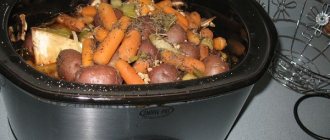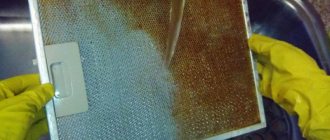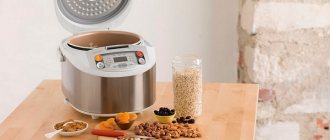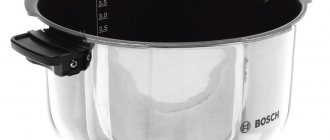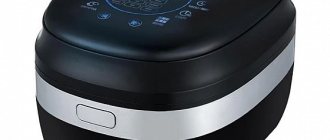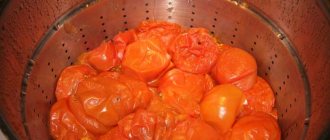When multicookers first went on sale, high hopes were placed on them. It seemed that this miracle of technology was capable of preparing a dish without human intervention, you just had to put the ingredients in a bowl and set the program. In reality, everything turned out to be a little different.
A slow cooker can save time and effort for those who figure out how to use it by reducing the amount of dirty dishes. But in order for your expectations to be met, it is important not only to handle this household appliance correctly, but also to keep it clean. How difficult is it? Let's take a closer look at how to quickly clean a multicooker.
Affordable recipes on how to wash the lid of a Redmond multicooker and get rid of odor and grease in the device
The invention of the multicooker can be called a salvation for many: people who are constantly busy at work have the opportunity to quickly prepare a variety of dishes. The device is also a valuable “assistant” in the kitchen for those who do not know how to cook or are just starting to get acquainted with cooking. As a true mistress of the kitchen, the multi-cooker is demanding that you follow the rules of its operation and care for itself .
Choosing detergents
During the cooking process, various food particles often get into the interior of an electrical appliance. Some housewives, in a hurry to prepare lunch or dinner, violate the rules for the sequence of placing food in a multicooker: they place food in the bowl without first removing it.
Such careless handling leads to contamination of the device contacts and its failure. To prevent such problems, the multicooker must be washed regularly.
To clean the unit, it is unacceptable to use hard sponges and abrasive detergents, as they can easily damage the internal and external parts of the device.
The best option for removing contaminants from the surfaces of the device are mild chemicals and home remedies..
Household
- Care kit for Zumman multicookers - the German product kit includes a liquid cleaning agent, wet wipes with varying degrees of lint hardness on the front and back sides. With the help of napkins, you can quickly and effectively remove dirt from any surfaces of the device; in case of significant accumulation of plaque on the elements of the unit, use the product in the form of a liquid.
- Top House is a gel designed for the care of household appliances used for cooking and non-stick cookware. To remove grease stains from a multicooker, apply a small amount of gel to a sponge, foam it and treat contaminated surfaces, then remove the remaining product with a damp cloth and rinse the device.
- Sanita spray “1 minute” is a domestic product that can effectively remove stubborn grease deposits and is suitable for cleaning various types of surfaces. After spraying the drug onto contaminated areas, wait 1-2 minutes and wipe the treated areas with a damp cloth, then rinse with water.
Folk
In some cases, the use of household chemicals is not suitable for caring for an electrical appliance: for example, a person experiences an allergic reaction upon contact with a certain product.
After using ready-made preparations for cleaning surfaces that will then come into contact with food, the treated containers must be washed several times in clean water. If the rinsing procedure is not carried out very carefully, the remaining chemical particles can have a negative effect on the living organism .
Citric acid perfectly cleans the microwave from grease.
Cleaning the device using traditional methods is an alternative option for removing contaminants from the multicooker elements.
It should be said that most available products have no less cleaning effect than special preparations:
- pour 25 g of citric acid into 200 ml of warm water, stir the ingredients;
- pour the solution into the bowl of the electrical device and turn on the steam cooking mode for 15 minutes, then drain the liquid, rinse the tank and wipe it dry.
Lemon will help get rid of plaque and eliminate unpleasant odor : pour a glass of water into the bowl, and place half a citrus fruit there. As with citric acid, turn on the device in steam mode for a quarter of an hour. After the time has passed, drain the liquid and wash the tank in running water and dry it.
Find out how to descale an electric kettle using citric acid. This article will tell you about cleaning your iron from limescale.
Cleaning the heating element
It is important to know how to clean the heating element in a multicooker, because dirt immediately sticks to it. You can wash it using the same methods as the inner surface of the device .
If the suggested recipes do not help, try this::
- lightly moisten the stains with a sponge;
- sprinkle with soda;
- after 10 minutes, clean the burnt dirt;
- Remove any remaining product with a damp cloth and then wipe dry.
Important! All sponges, rags and wipes used must be semi-dry. Water ingress into the heating element is unacceptable.
Cleaning the device by detail
All parts of the device require periodic cleaning, so remove the removable elements of the device: bowl, moisture collector and other parts.
Lid
Many models of Redmond brand household appliances are equipped with a non-removable lid, and most housewives have a question: how to wash this part of the device?
The procedure for caring for a lid of this type requires some skill and time.
Cleaning the non-removable lid with steam (without disassembling the multicooker):
- pour 200-250 ml of water into the bowl and put 1-2 slices of fresh lemon into the reservoir;
- turn on the device, close the lid and start the steaming mode for 15 minutes;
- After the device has finished operating, remove the bowl and drain the liquid;
- disconnect the multicooker from the power supply;
- protect the device body from possible moisture by wrapping it in polyethylene or cling film so that only the lid remains outside;
- tilt the unit on its side to prevent water from getting inside the equipment;
- wash the lid with a soft sponge and a soap solution applied to it;
- Wipe the part with clean water and dry with a cloth.
Caring for the removable cover:
- disconnect the device from the network, remove the device part;
- dilute a few drops of neutral detergent in a glass of water;
- soak a sponge in the solution and wipe the problem areas of the lid without touching the rubber elements and the fastening points of the element;
- remove soap scum with clean water;
- wipe the rubber elements with a damp cloth (without detergent);
- Wipe the lid with a dry cloth and place it on a clean multicooker.
IMPORTANT!
It is unacceptable to soak the part in water, as this may damage the fastening system.
Cup
The removable element of the multicooker has a special coating that prevents food from burning during cooking. The protective layer is easily damaged, so you should wash the bowl with extreme caution:
- tank with Teflon surface - the coating can be easily scratched if you use hard sponges when caring for the part. This surface does not tolerate temperature fluctuations, so allow the bowl to cool thoroughly before cleaning. Remove the removable part of the multicooker using special folding tongs or plastic or silicone spatulas.
- Ceramic coating is susceptible to chipping under slight mechanical stress. When washing the bowl, be extremely careful not to let the part fall or hit hard surfaces.
To remove dirt from the external and internal parts of the bowl, use a solution of dishwashing detergent (1/2 teaspoon per 200 ml of water):
- Dip the sponge into the cleaning product and lather it;
- apply the mixture to the container and gently, effortlessly rub the problem areas (if the plaque is old and ingrained, leave the preparation on the surfaces for 10-15 minutes);
- Rinse the tank with running water and wipe it with a dry cloth.
ATTENTION!
The bowl can be installed in the multicooker only after it has completely dried. Do not wash the container in the dishwasher.
Before replacing the bowl after washing, inspect the bottom, remove any debris and wipe the surface with a slightly damp soft cloth.
After cleaning, wipe the bottom with a dry cloth, leave the appliance with the lid open until the moisture has completely evaporated, and only then place the bowl.
Moisture collector
This element is designed to collect moisture that forms on the lid during cooking.
Remove the part and wash it after each use of the multicooker. To clean, use a soap solution or liquid dishwashing gel and running water.
After removing dirt, be sure to dry the container before replacing it.
Under the disk
Most models of Redmond multicookers are equipped with an internal lid made in the form of an aluminum disk. The part serves as protection for the steam valve and sealing the main lid with a seal.
The element also needs periodic cleaning:
- to carry out the procedure, open or remove the main cover, remove the internal disk (as a rule, it is secured with clamps or screws);
- wash the metal part with a mild detergent, rinse and dry thoroughly;
- put the disk back in place.
ATTENTION!
During the procedure for removing contaminants from the lid, it is advisable to clean the steam valve: simply wash the part in running water or soak in a soap solution, then rinse, dry and return to its original place.
Frame
The outer surfaces of the multicooker body will become clean again if you wipe them with a damp sponge soaked in a solution of a chemically neutral detergent.
After removing stains, treat the body with a cloth dampened in clean water and dry with a towel.
IMPORTANT!
It is strictly unacceptable to immerse the device body in liquid or allow moisture to penetrate inside. If water does leak into the housing, immediately turn off the device and dry it with the lid open for at least a day. During this time, you cannot use the multicooker.
Rules of care
But having already prepared their first dish, many women do not know how to properly clean the appliance. There are also those who use a dishwasher for these purposes, although manufacturers categorically do not recommend this.
Ceramic or Teflon
Teflon bowls allow you to cook any dish even without adding oil. Teflon is very convenient to use. Food doesn't stick to it, which means you don't have to peel or rub anything. But this statement is true only for undamaged coating.
Teflon is a plastic. The uniqueness of this coating lies in its slip and resistance to high temperatures (up to 260 degrees). In addition, it does not interact with acid and alkali. Unfortunately, such a coating is easily scratched and subject to mechanical damage. Even careful use will not extend the service life of the Teflon bowl for more than three years. And especially durable coatings, which are difficult to damage even with a knife, are very expensive.
When choosing a multicooker with a Teflon coating, you need to take care of special detergents. Do not use powders or abrasive gels. Hard sponges will also not work. As a result of their use, the coating of the bowl will be damaged, and in the future the food will always burn. A soft sponge and a kitchen balm or gel containing delicate cleaning agents will help you clean the inside of the multicooker.
An alkaline environment can damage the ceramic coating, so you should never wash such a bowl in the dishwasher. You only need to select soft, alkali-free products. During cleaning, you need to make sure that the bowl does not slip out of wet hands, since when dropped it quickly becomes covered with cracks and chips.
A ceramic bowl, like a Teflon bowl, can only be washed after it has completely cooled down. Temperature differences can damage the protective layer. The multicooker must be disconnected from the power supply and only then remove its elements for cleaning.
It is important to ensure that food does not burn. This will keep the bowl in working condition longer
You can avoid burning if you follow some important rules:
- Set the temperature according to the instructions.
- Do not exceed the permissible volume of products.
- Clean the valves in a timely manner.
- Wash off food residues after each preparation.
To remove burnt food, you need to pour a good quality dish gel and some warm water into the bowl. The container should be left for several hours. Then you should carefully remove the dirt without pressing and rinse the bowl under running water.
Cleaning the cover
Some models have a non-removable cover. It is much more difficult to wash it off. This cover is cleaned in two stages. First, pour a glass of water into the bowl and turn on the steam mode for 15 minutes. This helps clean away carbon deposits and dried-on food.
Then, when the multicooker has cooled down, you should wrap its body in a bag or cling film and open the lid. By carefully tilting the multicooker, you can wash the lid
But this must be done carefully so as not to wet the body.
Cleaning the body
If water gets into the case, you need to dry it with a hairdryer. After this, it is not recommended to use the multicooker for three to four days. You can't plug it into a power outlet either.
After cleaning, it is important to ensure that no moisture remains on the heating element, otherwise mold may grow there.
During cooking, moisture accumulates on the lid, then it enters the moisture collector and lingers there. After each cooking, it must be removed and washed under running water, and then blotted with a dry cloth.
Excess steam is removed from the device by a steam valve. When it is clogged, the milk porridge can escape. A clogged valve not only affects the quality of the prepared food, but can also lead to breakdown of the entire apparatus, so the valve must be thoroughly washed using any degreasing dishwashing detergent.
Some important tips on how to wash the inside of a multicooker:
- The first cleaning should be performed immediately after purchasing the device. Take a soft cloth and warm water. If there is an unpleasant odor, you can use a regular detergent.
- The multicooker must be maintained every time after use. Greasy marks need to be removed not only from the walls, but also from the heating element, lid and moisture collector.
- Cleaning the multicooker begins after the appliance has completely cooled down.
- It is strictly prohibited to treat the surface with hard brushes or abrasive cleaning agents.
If during cooking the food begins to burn to the bottom, this indicates that the device was not washed properly or the non-stick coating was damaged.
How to get rid of the smell?
You can eliminate unpleasant odors that appear in the appliance after cooking foods with a specific odor or resulting from burning food in the following ways:
- Smell of fish and seafood: pour 1.5 liters of water into a bowl and add 2 tablespoons of vinegar to it. Turn on the steam cooking mode, after completing the process, drain the solution, rinse the container with a cleaning agent, rinse and wipe the walls of the container with a dry cloth.
- The pungent odor can be easily eliminated by pouring several coffee beans into the multicooker bowl (after splitting them) and leaving them in the appliance for 8-10 hours.
- “Aroma” of burning: pour a liter of water into the tank, add chopped fresh celery or ginger. Boil the ingredients for 15-20 minutes, wash the bowl with clean water and leave it to dry.
- Plastic smell: make a solution of citric acid (1 tablespoon of powder per liter of water), pour it into the device’s container, turn on the device in steaming mode. After the procedure, drain the liquid and wipe the walls of the bowl with water.
Valve and moisture trap
The steam valve in a multicooker is one of its important parts. If the multicooker valve becomes clogged, liquids may splash out: porridge, milk, soups, etc., as a result of which you will have to wash the device to remove burnt food. For most devices, this element is removable and cleaning it should not be a problem. The valve is removed and washed under the tap with a cleaning agent. As for the moisture collector, it is a small container in which condensation collects when the lid is opened. It must be washed periodically, as during the cooking process food residues may get in there.
Important! When dismantling the steam valve, do not stretch the rubber seals, as this may lead to leakage.
How to clean the inside from grease?
If food residue gets on the heating element of the multicooker, follow these steps:
- disconnect the device from the power supply, open the lid, remove the bowl;
- wipe the internal surfaces of the device with a dampened cloth to remove dirt;
- If there are stubborn grease stains on the heating disk, use a soda solution (1-2 teaspoons of food product per glass of water) to remove them: soak a soft cloth in the product, wring it out and clean the element.
You will find 4 recipes on how to clean a multicooker from grease inside and outside in this article.
After the procedure, wipe the inside of the device dry and leave it for a few more hours with the lid open.
Features of washing a multicooker
A multicooker consists of many parts . They are different in shape and materials.
Things to consider when preparing to wash your multicooker:
- Before cleaning, unplug the device. The bowl and body must cool completely.
- It is advisable to wash the multicooker bowl after each cooking. Do not store cooked food in it.
- Do not leave a dirty bowl in a closed multicooker - food particles will quickly turn sour, and it will be difficult to get rid of the unpleasant smell. It’s better to take it out and soak it in warm water if you can’t wash it right away.
- Don't forget about the moisture collector. Water must be removed from it regularly, as it can also deteriorate.
- When using the device daily, it is enough to wash it inside and out once every 10-14 days. If you cook less often, you can limit yourself to once a month.
- If something spills out of the bowl or accidentally gets onto the bottom, heating element or valve, you need to wash it off as quickly as possible before the food dries.
- Before thoroughly cleaning the device, all removable parts are disconnected.
Attention! Thoroughly dry all cleaned multicooker elements before assembling and using.
Useful tips
- Every time before using the multicooker, make sure that no particles of food from previous cooking remain inside it, as this will lead to burning of the food;
- Wash the device after each use with mild detergents, periodically use special chemicals or household cleaners for cleaning;
- Store a clean multicooker with the lid open.
How to prevent pollution: tips and tricks
Tips and tricks for cleaning a multicooker
To clean the multicooker as little as possible, you just need to follow simple rules:
- Remove dirt as soon as you notice it.
- Make sure that crumbs do not fall under the bowl onto the heating disk.
- Before cooking, check that there are no crumbs or wet spots at the bottom of the bowl.
- Place the multicooker only on a clean surface.
- Wash the bowl and wipe the body of the device after each cooking.
- Make sure that the steam valve is not blocked, otherwise a rotten smell will appear.
Pollution prevention
Burning or leaking of food outside the bowl of an electrical appliance leads to the formation of persistent plaque and fatty deposits on the elements of the device. To avoid such troubles, follow these rules:
- set the temperature that will be optimal for the dish. You should not artificially speed up the cooking process (for example, for food that should be stewed, the cooking mode is selected).
- Do not forget to close the multicooker lid while the unit is operating.
- Do not exceed the permissible volume of loading food into the bowl.
- Do not store food in a bowl: after finishing its heat treatment, transfer the dish to another container.
Proper operation of a multicooker requires careful and careful handling of the device during its use and thorough, regular cleaning of the device.
Only if these rules are followed will the kitchen “sorceress” cook delicious food properly and serve for a long time.
Rules of care and prevention
To save time and effort in dealing with heavy dirt, it is important to systematically care for the multicooker and perform preventive cleaning.
Cleaning after every cooking
After cooking, you need to wash the equipment with soapy water: clean the bowl, steam valve, rubber seal, lid and moisture collector. The elements are then rinsed and wiped dry.
Do not cover with a towel while cooking
The cooking temperature is set in the selected program. Additionally, there is no need to close the multi-saucepan. Air circulation is disrupted and the temperature changes. Food begins to splash out of the bowl, hits the steam valve and onto the heating element. Trust your household appliances; using additional devices is not recommended.
Choosing the Right Cleaning Product
The amount of time and effort spent to achieve the result depends on the chosen means. Choose household chemicals with the least toxicity. It is better to give preference to natural remedies. Be sure to wash off any remaining product from surfaces.
Do not leave cooked food inside the bowl
Violation of this rule leads to the formation of a musty, unpleasant odor inside the multicooker. After cooking, the food is immediately transferred to a storage container or a regular pan. Even if the dish has been left in the multicooker bowl for only a day, you will not be able to get rid of the smell of “former” food right away.
Do not use metal cutlery
Do not remove old or burnt stains in a multicooker with a knife or other metal cutlery. There will be scratches on the surfaces, the result will not be satisfactory, and the equipment may be damaged.
How and how to clean the multicooker lid from grease - choosing a product
When cooking in a multicooker, greasy stains form on the lid, which over time become firmly embedded in metal and plastic, and are not so easy to remove. Tips from experienced housewives will tell you how to clean the lid of a multicooker from grease inside at home. All cleaning methods are easy to use, but effective in action.
Removing grease from the lid
The removable lid of the multicooker must be removed and cleaned with a sponge and dishwashing detergent, and then thoroughly wiped with a towel, wait until completely dry and put back in place.
You can wash the non-removable lid from grease and dirt using the “steamer” mode: pour 1-2 glasses of water into the bowl, add a slice of lemon (or add a little lemon juice), and set the timer for 20 minutes. Then drain the water, cover the device with film so that nothing falls inside, and wipe the lid from dirt with a napkin. This cleaning also eliminates unpleasant odors.
Preparing for cleaning
First, try removing the cover from the device, then it will be easier to clean. If the cover does not come off, this will make the process a little more difficult. As a way to prevent the cleaning agent from getting inside the multicooker, put a plastic bag over the cup itself. It will prevent splashes from getting inside the cup. After cleaning, just in case, rinse the cooking container with clean water. In many models, the cups can be pulled out, so it is better to remove it from the multicooker for a while.
Unplug the device from the outlet to avoid electric shock. The multicooker itself should not be hot; if you recently cooked something in it, let the device cool down. First, remove any old food from the lid, then you can begin cleaning.
Cleaning the multicooker bowl
The bowl is the very container in which the dish is actually prepared. The coating of the bowl is a non-stick surface that prevents food from burning during cooking. That is why you should care for and wash the bowl with care and caution.
Important! Before using the multicooker, it is important to make sure that there are no food particles left inside the bowl from previous cooking, as this can lead to burning and sticking of the food.
Ceramic surface
Ceramics does not tolerate shock and can crack even with slight mechanical stress. The ceramic bowl should not be washed in the dishwasher. It is better to clean it manually using dishwashing gels without strong chemicals. It is also not recommended to clean the surface with soda and other powders, since the abrasive will each time shorten the service life of the container.
It is worth noting! You can purchase gels for washing multicookers with ceramic bowls at most dishware stores.
Teflon surface
Teflon really doesn't like scratches. That is why it is recommended to use special plastic or wooden spatulas to remove the dish from the bowl. It is also worth noting that Teflon coating does not withstand temperature changes. Therefore, before you start cleaning, you should let the bowl cool to room temperature. To speed up the process, you can remove the bowl from the body.
Chemicals
On store shelves there is a huge selection of cleaning products that contain surfactants. Surfactants effectively cope even with complex old traces of fat, literally removing them from the surface in a matter of seconds. The products have a convenient gel or liquid structure; after application, you need to rub the lid a little with a sponge and leave to act for 5-10 minutes. Then rinse the product off with water several times and wipe the lid with a damp cloth. The most popular means for removing fat from a multicooker lid are:
- Mr. Chister;
- Sanita;
- Comet;
- Sif;
- Amway.
Before you start cleaning, read the instructions for using household chemicals. The instructions set out a detailed procedure for how to use the gel or liquid; you cannot deviate from the recommendations.
Lid
To wash the multicooker lid, first of all, you should determine whether it is removable or non-removable. In the first option, everything is simple - the lid is removed and washed under running water using a sponge and cleaning agent. For the option with a non-removable lid, the case should be covered with plastic wrap or placed in a plastic bag, and the lid itself should be left outside. The body is tilted towards the tap and the lid. It is worth noting that most models of Redmond and Polaris multicookers have the ability to remove the disc from the multicooker lid for washing it.
Important! The multicooker is an electric appliance, so getting it wet is highly not recommended.
Folk remedies
If you deliberately do not use household chemicals, or there is no suitable product at home, there are many ways to remove traces of grease at home. Surely every kitchen has baking soda or vinegar, and in the bathroom there is simple laundry soap. All products remove yellow fatty traces without much difficulty. For more effective cleaning, use a stiff sponge or bristle brush. It is better not to use metal meshes; they can severely scratch the surface.
Laundry soap
Laundry soap helps to get rid of traces of grease. Lather the sponge with it and rub the hard side over the surface of the lid. You can leave the lid in the soapy solution for 10-15 minutes, then rub again and rinse repeatedly with clean water. For greater effectiveness, add a couple of drops of dishwashing liquid to the soap. The fat and smell from it will disappear instantly. After cleaning, wipe the lid dry with a cloth, the device can be used immediately.
How to cleanse with lemon water
If dirt has recently appeared on the multicooker lid, it can be easily removed. Pour water into a glass cup and squeeze the juice from one lemon into it, stir. Then place the plate in the multi-cooker cup and turn on the “steam” mode. Heat should be low for 5-7 minutes. Then open the lid, carefully take out the water, the cup is hot. Citric acid together with steam will make the fat more plastic, so it can be easily wiped off with a damp cloth. For wiping, you can use diluted lemon juice or a solution of citric acid. Dissolve half a lemon juice or 1/2 tsp in a glass of water. acid, wet a cloth and wipe the lid.
Vinegar
Vinegar perfectly removes not only traces of grease, but also unpleasant odors after cooking. Dilute tbsp. vinegar in a liter of water, soak a rag in the solution and wipe the lid. If the stains are old, place a glass of water in the multicooker container and add a teaspoon to the water. vinegar. Turn on the “steam cooking” mode. The vinegar will evaporate and help remove the grease from the surface of the lid. When finished, simply wipe the surface dry with a microfiber cloth.
The substance is used not only in cooking, but also helps get rid of fat. Dilute a couple of tablespoons in 20-30 ml of water. baking soda to make a thin paste. Apply the gruel to the contaminated surface and rub in with the hard side of the sponge until the yellow spots disappear. Leave the baking soda to act on the surface for 5-10 minutes, then remove the remaining powder with a damp cloth and wipe dry with a paper towel. Instead of soda, you can take salt or mix half and half with soda.
How to properly wash a bowl
The multicooker bowl may have a Teflon or ceramic coating. They both provide a non-stick effect and require gentle handling when cleaning.
Containers with any coating are washed as follows::
- Pour some warm water into the bottom.
- Add 1-2 drops of dishwashing detergent and leave to soak for 5-20 minutes, depending on the degree of contamination.
- Wash off the product and food particles with a foam sponge.
- Rinse well with water, wipe and dry.
Advice. If the bowl has been washed, but the smell of the dish remains, boil water with a slice of lemon in the multicooker for 10 minutes on the “Steam Boiler” mode.
The rules for cleaning the bowl are simple - no abrasives or caustic liquids. But each of the two materials will have to be given special attention.
Teflon bowl
To preserve the properties of the Teflon coating, protect it from scratches. Do not try to clean the surface of the bowl with hard sponges, scrape dried-on food with metal objects, or rub vigorously and for a long time.
If the stains are not washed off the first time , they are soaked in warm water with a mild detergent. After half an hour, dried or burnt food will easily separate from the walls.
Note! A sharp change in temperature contributes to the formation of microcracks in the Teflon coating. Do not cool a hot bowl by pouring cold water into it. Before washing, wait until the container cools down on its own. To speed up the process, remove it from the multicooker.
Ceramic bowl
The resulting chips and cracks most strongly change the properties of the ceramic coating of the bowl. Do not drop the container, place or throw heavy objects, dishes, or cutlery inside. You shouldn't rub or scrape ceramics either.
A container cleaned with soda or powder may lose its non-stick properties Even the softest abrasives will leave microcracks on the surface.
Washing Tips
To clean the multicooker lid without any effort, remember a few simple but very practical tips. They will come in handy more than once when cleaning, but will not harm the device:
- When washing, do not touch the fasteners and sealing rubber;
- It is better to start cleaning the day you use the multicooker, but you need to give it time to cool down;
- If fat has accumulated in hard-to-reach places, take a toothpick or match. Q-tips may come in handy;
- After cleaning, wipe the rubber inserts dry with a clean towel so that no traces of the cleaning agent remain on them.
The multi-cooker lid must be washed after each time you use the device. If you do not constantly take care of your multicooker, unpleasant odors and fat particles will get into your food. Spend only 5 minutes on washing, and then you will not need to wash the lid with household chemicals, and the multicooker itself will serve you for many years.
Recommendations
To make the owner happy with the result of washing your beloved assistant, you can use the following recommendations:
- If it is possible to unscrew the removable elements, do so.
- Never use powders or other products with abrasive ingredients.
- Avoid temperature changes; do not wash the multicooker with cold water.
- After finishing washing, wipe the kitchen unit dry.
The quality of cleaning the multicooker depends on the choice of detergent.
Liquid dishwashing gel
Simple daily dirt, carbon deposits and grease can be easily removed using a traditional liquid gel dishwashing detergent.
After washing, it is important to completely rinse off any remaining product and wipe the multicooker dry with a soft cloth.
Soft sponge or cloth to wipe dry
When choosing a material for wiping, you need to pay attention to the fluffiness of the napkin, rag or sponge. There should be no pellets or hairs left on the surface of the multicooker, especially on the heating element.
They may burn or get into your food. In addition, the cloth should be soft so as not to leave micro-scratches or damage on the surface.
How to clean the bottom?
The bottom of the multicooker is cleaned when the heating element has cooled down. Minor stains can be easily removed with a damp cloth. When removing burnt fat, you can use baking soda or citric acid, which has a dual effect: it removes old stains and unpleasant odors, and also disinfects the surface. You can clean the bottom using cotton pads and a soft, lint-free cloth.
How to clean the lid?
The multicooker lid is in close contact with the food being prepared. Consists of a steam valve, surface and rubber seal. To properly clean the lid, the elements must be separated.
Removable
All removable elements of the multicooker are washed separately, cleaned of old dirt, rinsed thoroughly, wiped dry and assembled.
Fixed
When washing a non-removable lid, the main part of the kitchen appliance is covered with polyethylene and tilted over the sink. After all manipulations, household appliances are rinsed and wiped dry.
Washing the moisture collector
The moisture collector collects remaining condensation and moisture after cooking. It must be washed after each cooking. The collected water is drained, and the container itself is washed with soapy water and wiped with a soft sponge.
How to clean a steam valve
The correct taste and aroma of cooked dishes depends on the cleanliness of the steam valve (be it a Redmond or Polaris multicooker). If the steam valve is dirty, the steam does not find a way out of the pan body, the cooked food “runs away”, and often floods the heating element.
Remaining food and fat particles create an unpleasant odor inside the multicooker. First of all, the valve is washed with running warm water, then cleaned with a brush to remove dirt using citric acid, rinsed, wiped dry and installed in place.
The outside of the multicooker is cleaned using household chemicals. You can use melamine sponges and cleaning powders. In order to remove fingerprints from chrome surfaces, you can use products containing ammonia.
